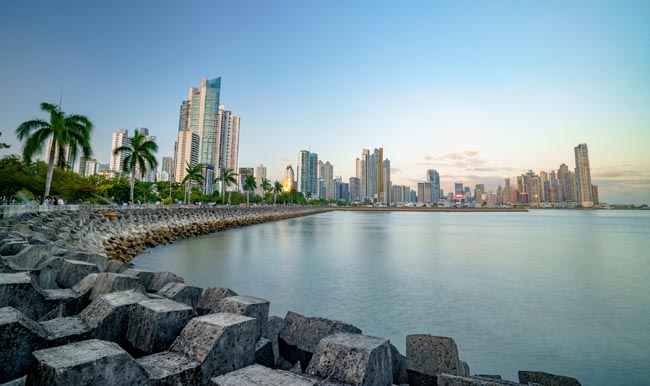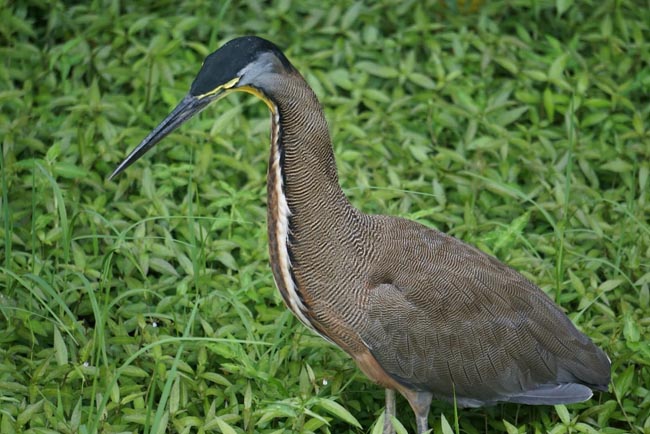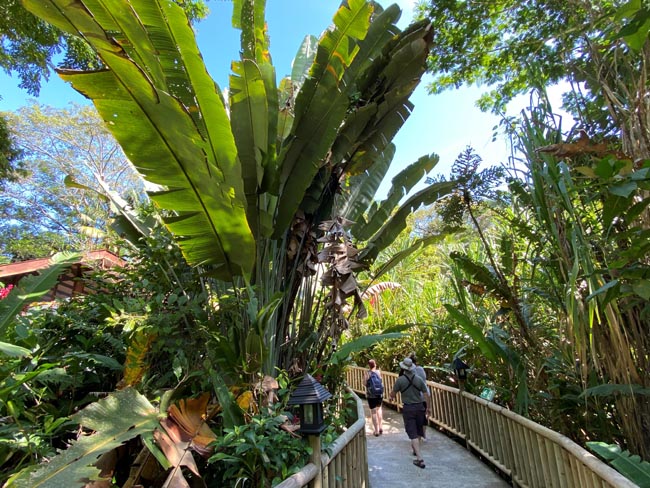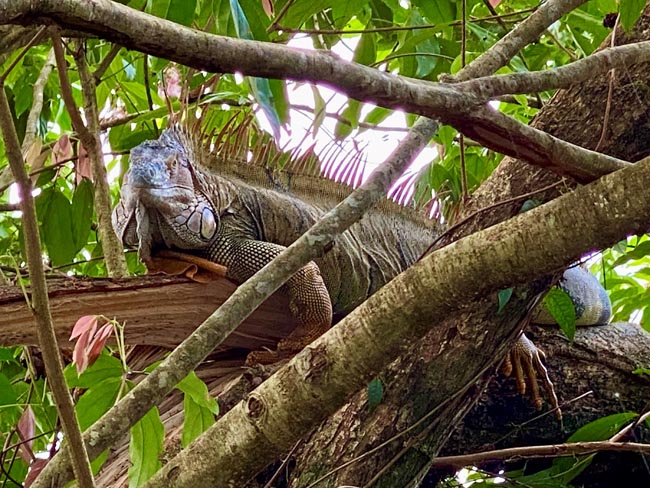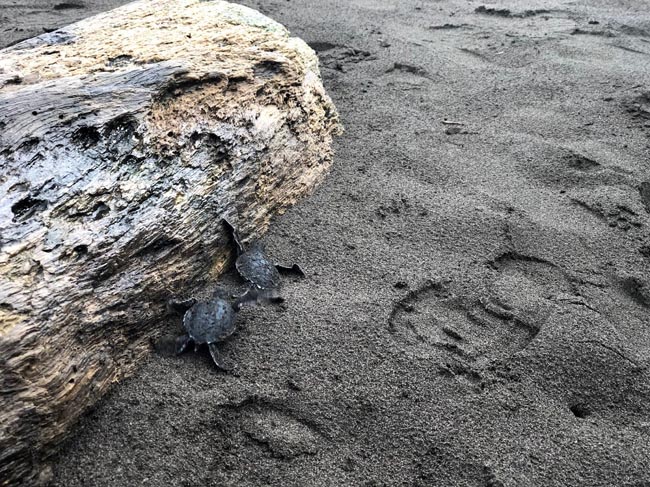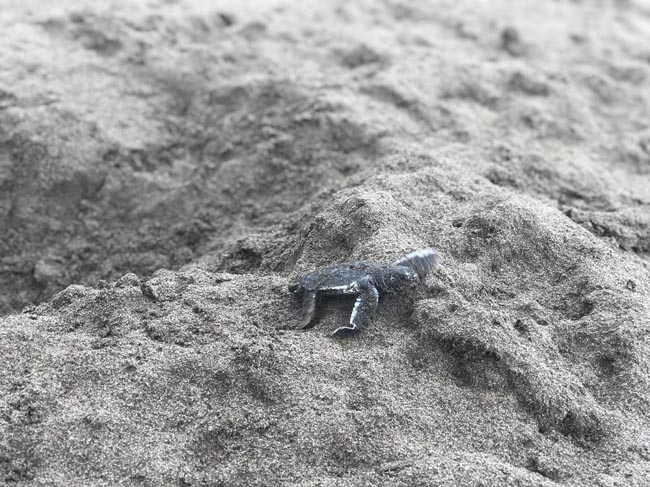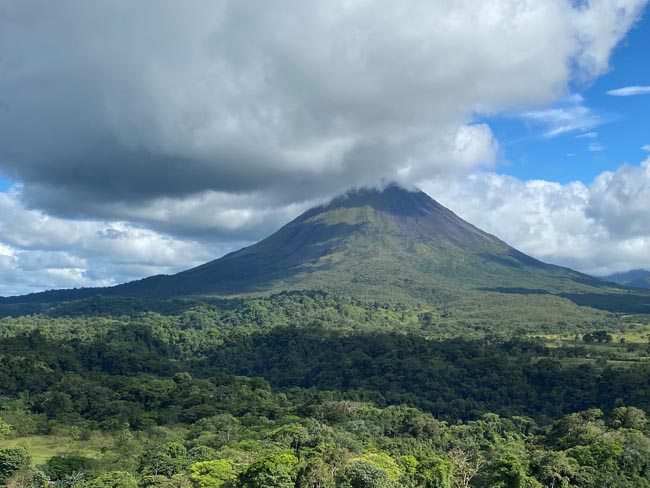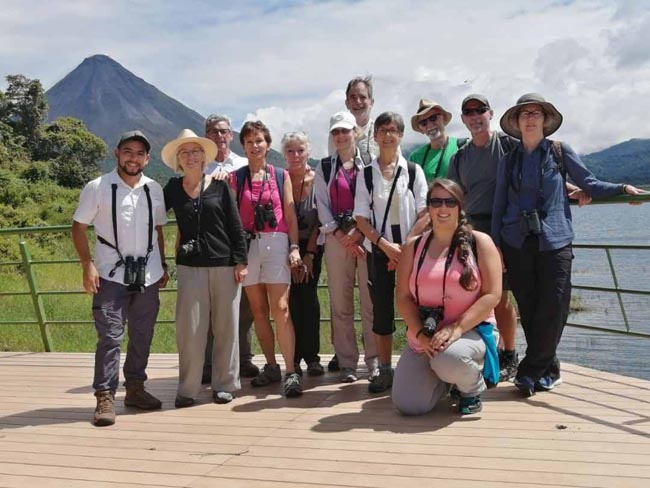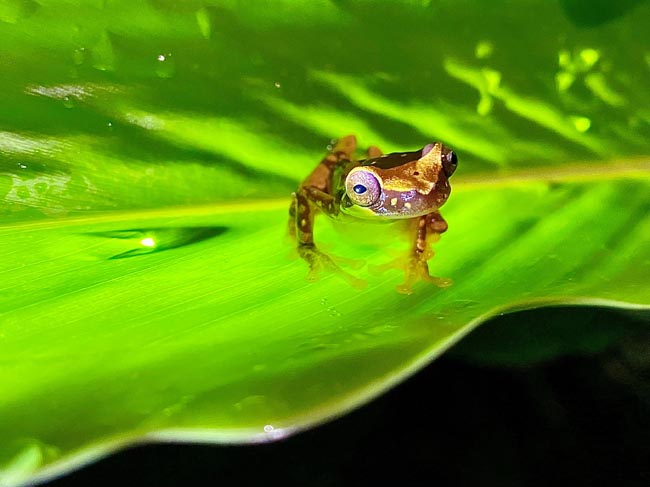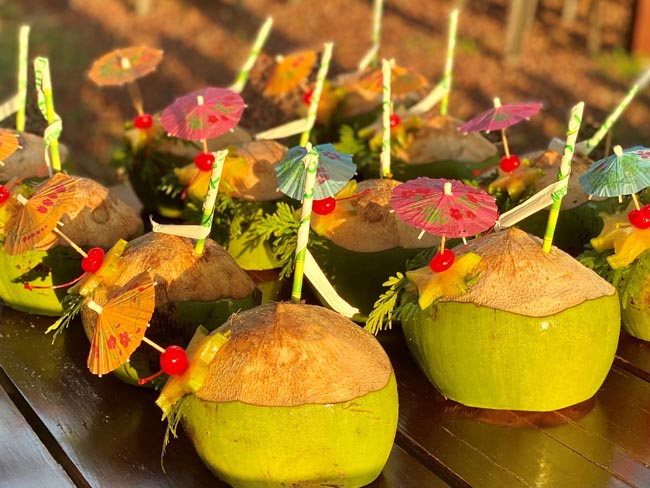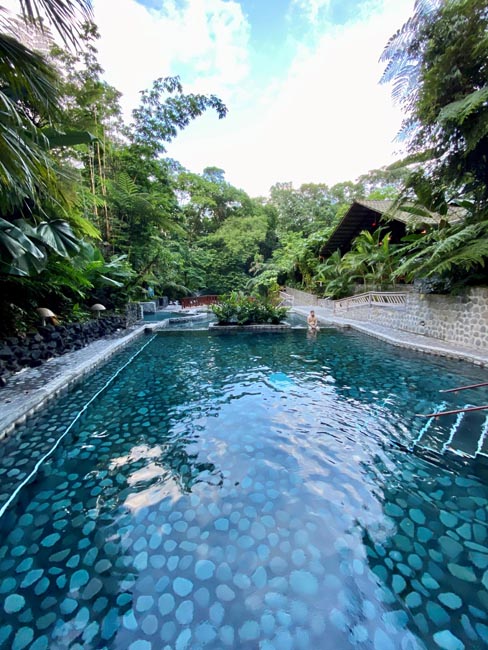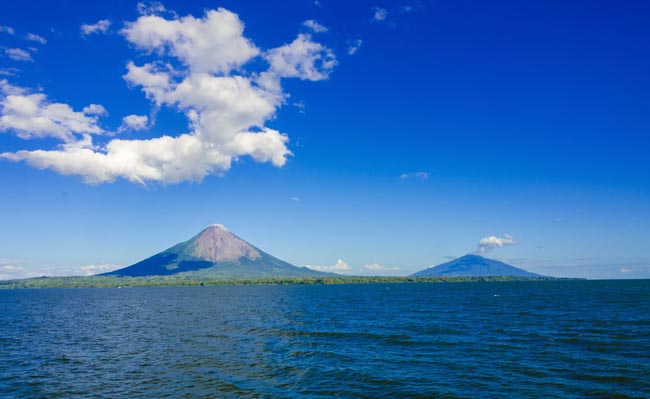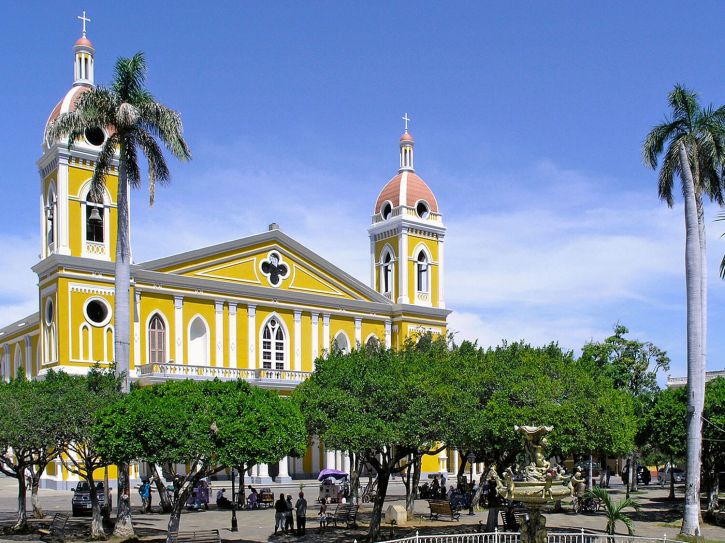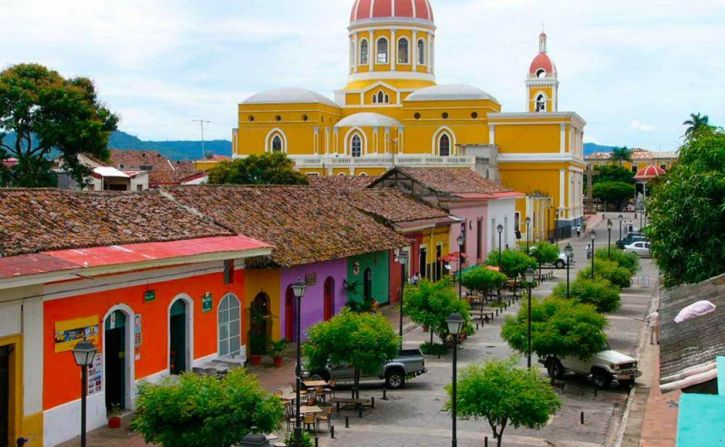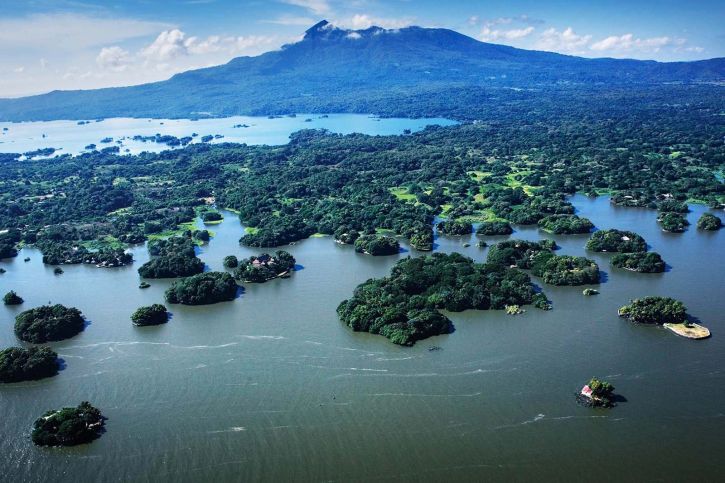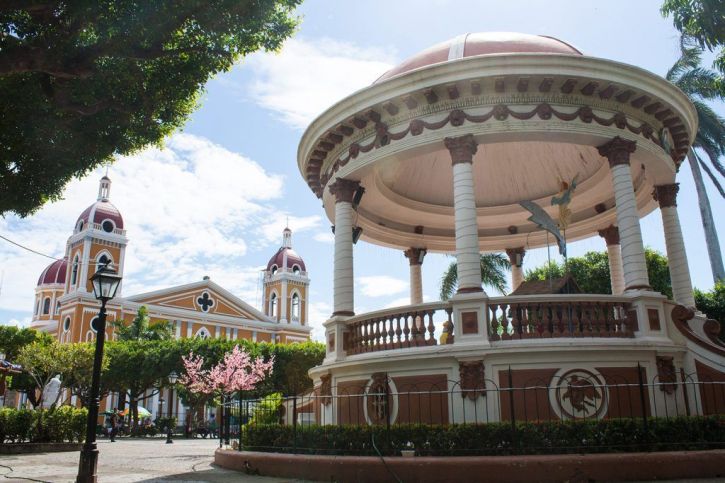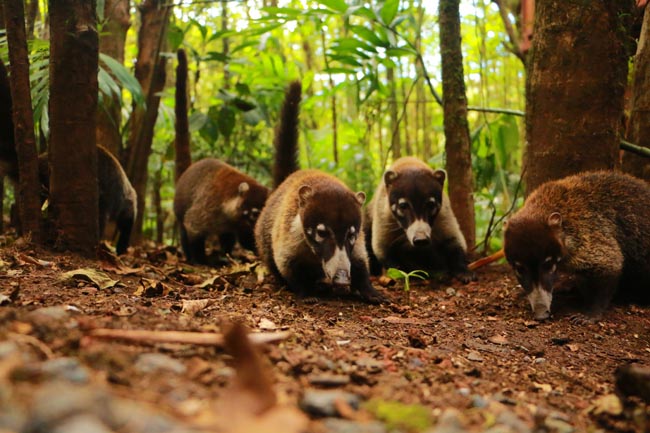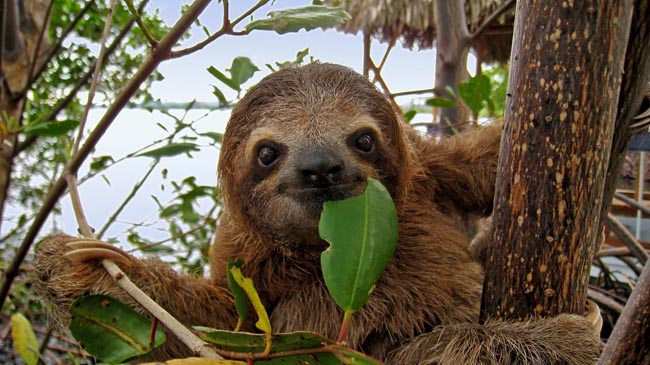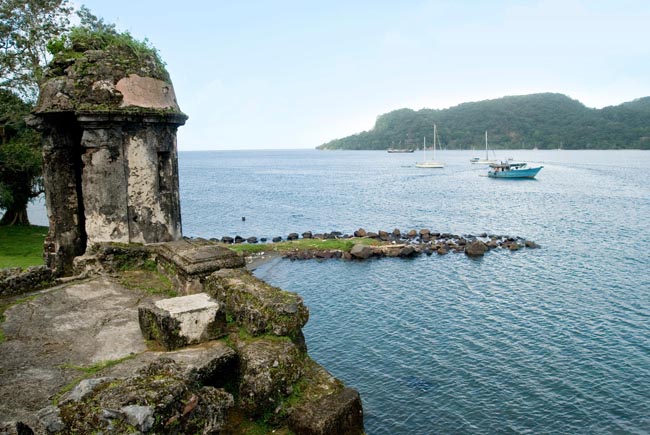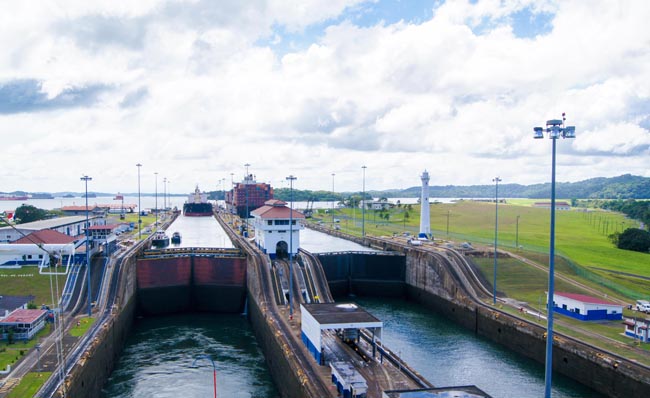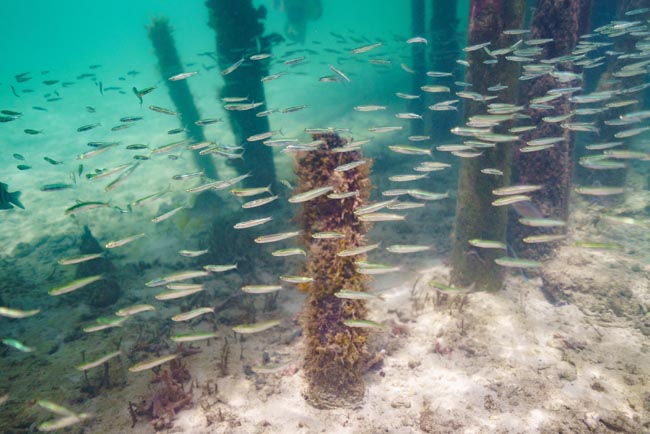On our Panama, Costa Rica & Nicaragua tour you'll find yourself gliding through the waters of one of the most famous landmarks in the world, the Panama Canal, is the first of many adventures on this exciting 23-day tour through Panama and the naturalist dreamlands of Costa Rica & Nicaragua.
Taking 34 years to reach completion, the Canal stands today as a marvel of design, engineering and human enterprise and is one of the must-see attractions on a tour of the fascinating country. That said, the nation's bounties are by no means restricted to the Canal alone and we discover that Panama in fact has a wealth of other lesser-known attractions, from the historic trails in Soberania National Park and the natural wonder inherent in the primeval rainforests Chiriqui Highlands and Boca del Toro, to the bustling streets of the capital, Panama City.
Crossing into Costa Rica, we begin this stimulating leg of the journey by casting off for a boat trip along interconnecting rivers and canals through remote and untouched wilds to the Caribbean coast. Lush vegetation and unique bird life line the narrows of our course in the Tortuguero region and then it's back onto land for a visit to the museum to learn about the local ecology and to witness it for ourselves with later expeditions into the fairytale-like Monteverde Cloud Forest.
Our time in Nicaragua features beautifully-located Granada, with views of multiple volcanic islands, charming colonial architecture, and some of the friendliest people you'll ever meet.
Prices below are per person, twin-sharing costs in US Dollars (USD). Pricing does not include airfare to/from the tour and any applicable taxes. For single supplement rates and taxes (if any), please refer to below Prices & Dates table. For general information on flights to/from the tour, click here.
Your Travel and Accommodation Arranged For You
Tips Included for Driver, Restaurant Staff, Local Guides
Authentic Local Experiences With Lots Of Inclusions.
Select a date below to reserve your spot:
The above prices are subject to an additional $100 for taxes/fees levied on flights that occur as part of the tour. The internal airfares ARE included (any exceptions are listed in red below), but we list the taxes separately on your invoice as they are beyond our control and can change at any time.
Optional Single Supplement: $1660 USD (number of singles limited).
Download Itinerary
Day 1 Arrival in Panama City
Arrival at Tocumen International Airport, Panama City.
The most cosmopolitan capital in Central America, Panama City is both vibrant metropolis and gateway to tropical escapes. Welcoming both east and west, Panama is a regional hub of trade and immigration. The resulting cultural cocktail mix leads to a refreshing attitude that's dynamic and fluid.
Overnight in Panama City.
Included Meal(s): Dinner
Day 2 Partial Canal Transit
We have an early morning pick-up at the hotel for the 15 minute drive to the port of Balboa where we board the passenger ferry that will take us on the world famous journey through the Panama Canal ("partial" transit; one-way). For many, this tour is a once-in-a-lifetime experience. At the MiraFlores Locks we experience how ships are raised 16 m / 54 feet in a two step process. This activity is achieved by sending water from Pedro Miguel's lake by gravity to fill the chambers where the ship is locked. Once the first set of locks is transited, the vessel arrives at the Pedro Miguel locks to be raised up to 26 m / 85 feet. Again no water pumps are used; they take advantage of gravity to transfer water from Gatun Lake, filling the last Chamber of the Pacific site. We cross the Continental divide and narrowest part of the Panama Canal arriving at the town of Gamboa, home to the dredging division, an important part in the functioning of the canal.
The tour includes breakfast and lunch and a specialist guide. Light clothes, insect repellent, hat, sunscreen and very comfortable shoes, are suggested. Do not forget your camera!
Overnight in Panama City.
Included Meal(s): Breakfast, Lunch and Dinner
Not finding what you're looking for?
Our specialists can take away the stress and create a private custom tour tailored to your exact interests and budget.
Day 3 Panama City: Portobelo & Agua Clara Locks
Today we travel by bus to Portobelo, once the main port of entry and exit for all of South America. The exchange of merchandise took place annually at Portobelo in the form of a "fair," which lasted from 30 to 60 days. During this time, this sleepy little place was a beehive of activity; indeed transactions frequently totaled from 10 to 12 million gold pesos! These fairs took place once each year until 1738 when, as a result of continual attacks by pirates, Spain was forced to abandon the Isthmian route for the longer but more secure one around Cape Horn. The frequent pirate attacks forced the Spaniards to adopt a convoy system; each year two fleets of 40 to 70 ships sailed from Spain, one bound for Veracruz, the other for Portobelo. Portobelo is a shadow of it’s former glory but is still quite quaint and charming.
Our visit begins with San Filipe Church, the Church of the Black Christ, named for a wooden statue of Jesus Christ found on the shores of the town's harbour. Life-size, it's adorned with a robe that is changed twice a year, once during the Festival of the Black Christ and also during Holy Week. There are many legends about how the image came to rest in Panama: a shipwreck, a miracle, a saviour from the black death. This was the first church of mainland America.
We then walk to the Customs House, passing by the stone inlay sundial and gold measures. This is where the majority of the gold was stored before being sent to Spain. Next to the Customs House is Fort San Geronimo. A ten-minute walk through town takes us to Fort Santiago -- across the road from the fort, there are steps that lead up to ruins of old battlements. The view from up here is stupendous!
Our last stop is Agua Clara Locks and Visitor Centre, the third set of locks that opened in 2016. Of particular interest are the locks’ fascinating overflow tanks that allow for 60% of the water to be recycled as the ships go through the locks. Hopefully our visit will coincide with a ship in the canal!
Overnight in Panama City.
Included Meal(s): Breakfast and Dinner
Day 4 Parque Metropolitano & Amerindian Village
Today we head north of downtown to Parque Metropolitano, which protects vast expanses of tropical semi-deciduous forest within the city limits and serves as an incredible wilderness escape from the trappings of the capital. Our walking route takes us to 150m-high mirador (lookout) with panoramic views of Panama City, the bay and the canal all the way to the Miraflores Locks.
This afternoon we visit an Embera / Choco Amerindian village. We take a boat along the route commonly used by the Indians for their daily transport along the river. A short walk through a forest follows, with a local guide to explain botanical novelties and the culture of this authentic village. We return to Panama City.
Overnight in Panama City.
Included Meal(s): Breakfast and Dinner
Day 5 Panama City Touring - Fly to David, Chiriqui Highlands
This morning, still in Panama City, we include a visit to the ruins of Old Panama and Casco Viejo (the old city compound) dating back to the late 1600's.* We will learn of the events in history leading up to the eventual movement of the capital city to its present location. Casco Viejo is home to monuments to Ferdinand de Lesseps and others who were instrumental in the ill-fated French attempt to construct a canal through Panama. Here we visit the Altar de Oro at the San Jose church. As it's name would suggest this large barouque altar is made of pure gold. The church was built soon after the first Spanish settlement was established on the Pacific Coast in 1519. In the 17th Century this settlement was abandoned and moved to it's present location on the small peninsula that that contains the San Felipe district of the city. When the church itself was moved so was it's most famous possession. Our tour ends with a visit to the Panama Canal Museum.
Later today we'll transfer to Panama City's Albrook domestic airport where we board the scheduled flight to David in the province of Chiriqui.**
This enchanted land is the Chiriqui Highlands, the part of the Cordillera Central that defines the northern border of the province of Chiriqui. Primeval rainforests bedecked with clouds, noisy, chattering birds flash brilliant iridescent colours as they dart about their daily chores, flowering epiphytes bloom en masse high above the forest floor while gurgling streams glisten and tumble hurriedly over great boulders in their dance towards the sea. It is a beautiful landscape of cloud forests, volcanic peaks, coffee plantations and home to most of Panama's Guaymi Indians.
* Flight schedules may have us flying to David this morning in which case the above listed Panama City sightseeing will be accomplished on Day 9.
** Due to 12 kilo weight restriction on this flight and on the flight from Bocas back to Panama City, we strongly recommend that you pack a smaller bag for the next few nights and leave excess baggage in storage at our Panama City hotel.
Overnight in Chirqui Highlands.
Included Meal(s): Breakfast and Dinner
Day 6 Chiriqui Highlands
Today we will travel to Cerro Punta to explore the area with a local naturalist guide on a nature walk.
This area is good for resplendent quetzal, black and yellow silky flycatcher, prong billed barbet, and the volcano hummingbird. From here we'll travel to the area of La Amistad International Park Headquarters. La Amistad is a bi-national park that stretches from Costa Rica into Panama, a small portion of which extends into the Chiriqui province encompassing mostly cloud forests. Here the land rises in excess of 1500 m / 4,950 feet and warm air ascends the mountains where it meets with cooler air and condenses into a persistent cloud cover. Cloud forests exhibit a unique ecosystem with an astonishing diversity of flora and fauna.
We also tour Haras Cerro Punta, a thoroughbred breeding farm in a mountain valley between Cerro Punta and Guadalupe – the highest inhabited part of Panama. The 100-hectare farm is surrounded by one of the most fertile agricultural areas in the country. With an average population of 200 animals, the farm turns out racehorse champions for Panama and beyond.
NOTE: The order of our Chiriqui sightseeing may vary due to weather, accommodation availability, and other logistical considerations.
Overnight in Chirqui Highlands.
Included Meal(s): Breakfast and Dinner
Day 7 Chiriqui Highlands - Bocas del Toro
After a leisurely morning we prepare for our drive to Almirante on the Caribbean side of the country. En route we stop to view the impressive Fortuna Dam and spectacular waterfalls along the Continental Divide. We will be crossing the Palo Seco Protected Area that serves as buffer zone to La Amistad International Park. The transition from the cloud forests to the coral reefs of Bocas del Toro is impressive. In Almirante we are met by our boat and transferred to the island.
Five hundred years ago, Christopher Columbus arrived at a tropical paradise he named Bocas del Toro. Overwhelmed by the most incredible contrasts of vivid colour and sheer unspoiled natural surroundings, Columbus decided to drop anchor and spend a bit of time in this idyllic place. Not much has changed since that pristine time with the exception of the provocative Calypso beat and the alluring accent of the Caribbean inhabitants. Bocas is the best place to sink your toes in the white sand, to explore lush tropical rainforests and coral reefs and to look for the faithful sea turtles that have come to these islands for millennia.
Overnight in Bocas del Toro.
Included Meal(s): Breakfast and Dinner
Day 8 Bocas del Toro
Ninety-two percent of this island is covered by tropical forest that helps keep a natural balance of the ecosystem. This huge national patrimony has 200 species of plants, 55 amphibious and reptiles, 57 mammals, 200 types of birds, 1500 bugs, and more than 58 species of corals.
Bocas del Toro Province is bordered by the Caribbean Sea to the north, Veraguas Province to the east, Chiriqui Province to the south and Costa Rica to the west. Most of the province is on the slopes of the Talamanca and Central mountain ranges, but the majority of its 93,000 inhabitants live in low-lying areas along the coast and on islands.
The province contains the large Archipielago de Bocas del Toro at the mouth of the Laguna de Chiriqui, beginning 35km from the Costa Rican border. The chain consists of 68 islands and numerous mangrove keys. Around them are fields of coral, a titanic variety of marine life and water so emerald in colour that Christopher Columbus named the region Veraguas, a contraction of verdes aguas (green waters).
Today we have a boat tour to the surrounding attractions of the island so you can appreciate the incredible beauty of this place. There will be time for swimming in the surf and walking along the coastline to Red Frog Beach where you will be amazed by a sort of symphony of rather non-musical chirping that sounds like it must be coming from crickets. When you look closer, however, you will be surprised to find that this strangely beautiful noise is coming
from a small frog, about the size of your thumbnail.
Overnight in Bocas del Toro.
Included Meal(s): Breakfast and Dinner
Day 9 Bocas de Toro - Fly to Panama City: Panama City Touring
This morning we hope to have some leisure time in Bocas before flying back to the capital this afternoon.
Balance of the day at leisure prior to reconvening for our evening meal.
Overnight in Panama City.
Included Meal(s): Breakfast and Dinner
Day 10 Panama City - San Jose, Costa Rica
Today we fly from Panama City to San Jose, Costa Rica.
San Jose, the capital of Costa Rica, is on a plateau in the Central Valley at 1200m (3,700 ft), ringed by lush green mountains and valleys. The population of this city is probably half of the whole country! The main downtown area is a bustling collection of well-laid-out streets filled with bustling traffic and lined with eclectic, historic architecture. On the surface, it is a gritty downtown area, but you'll also find friendly people, quirky spots, and the historic side of San Jose which might just change your initial impression.
Overnight in San Jose.
Included Meal(s): Breakfast and Dinner
Day 11 San Jose - Boat to Tortuguero
This morning we travel by bus from San Jose through Braulio Carillo National Park, one of Costa Rica's largest. If season/harvest time permits, we will visit a working banana plantation and then pass through a region known for its cocoa production. We then board our riverboat* and spend the afternoon journeying through myriad interconnecting rivers and canals that take us finally to the Caribbean coast and Tortuguero Park.
The park is a water thoroughfare which is a 160 km (100 mile) stretch of natural rivers, lagoons and estuaries, and connecting man-made waterways that run almost to the Nicaraguan border. The canal is the main "highway" of the northern coastal region, complete with directional signs and branches from the main trunk route.
As we go along the canal, keep a keen lookout for views of pastel-coloured toucans and monkeys of various type; if we're lucky, a lazy sloth hanging from a branch, and maybe a coati or two roaming the forest. Stands of mangroves and water hyacinth appear here and there. Scattered along the way are people, too -- fishers and farmers whose dugouts serve all the purposes of pickup trucks elsewhere. Mostly the banks remain wild, and the calls of monkeys and whistles of birds predominate over the noises of humans.
* We strongly recommend that travellers bring a smaller bag to take to Tortuguero due to limited sapce on the boat and the lack of personnel to help you with baggage. Your luggage will be securely stored until we are reunited with it upon departure from Tortuguero.
Overnight in Tortuguero.
Included Meal(s): Breakfast, Lunch and Dinner
Day 12 Tortuguero: Forest Walk & Village
Tortuguero Park is a fascinating place to explore. An early morning boat ride offers an opportunity to observe an awakening coastal rain forest full of lush vegetation and unique bird life.
After lunch we visit the village of Tortuguero accessible only by river boat; you may choose to walk on the Caribbean beach where several turtle species lay their eggs each year. We will visit the Tortuguero Museum with its excellent displays pertaining to the ecology of the area and an informative video presentation specific to turtle conservation in Tortuguero and the entire Caribbean region (the Green Sea and Hawksbill turtles' nesting season runs from July to October with the peak in August, and the Leatherback turtles nest from February to April. It is possible to see individual turtles at any time of the year).
NOTE: The exact order of our activities in Tortuguero may vary depending on weather and other variables.
Overnight in Tortuguero.
Included Meal(s): Breakfast, Lunch and Dinner
Day 13 Tortuguero - Baldi Hotsprings - Arenal/La Fortuna Area
After an early breakfast we travel by boat 1½-hour to reunite with our land transport and then continue by road to the La Fortuna/Arenal area.
We travel through rolling hills covered with sugar cane fields to overnight near Arenal Volcano. We make a stop at the Baldi Hotsprings (located near Arenal and outside the Risk Zones established by the National Prevention of Risks and Emergency Commission). Here a geothermally-heated river flows through beautifully landscaped grounds featuring many plant and tree species and great birdlife. We will have time to relax in or around the various pools (bring a towel). The springs feature several hot pools with different temperatures fed by individual springs and three swim-up bars.
This evening (weather & volcanic activity permitting) we can view the volcano.
Overnight at Arenal/La Fortuna.
Included Meal(s): Breakfast and Dinner
Day 14 Arenal - Monteverde Cloud Forest
Today we travel through a rustic rural countryside to the Monteverde Cloud Forest Reserve area (+/- 4 hours).
Covered in a mantle of moss, ferns and orchids, this private reserve is home to over 400 species of birds and a great number of animals. The forest is created by the winds, particular temperature and moisture conditions, and mountainous topography which combine during the dry season to hold a steady cloud cover along the continental divide. The rains and the moisture in the air nourish trees and plants rooted in the ground, as well as many plants that live at the upper levels of the forest, and take their nutrients directly from the mist and dust that pass through the air. The result is an enchanted fairy-tale environment where trees are laden with orchids, bromeliads, mosses and ferns that obscure their branches, where the moisture and mild temperatures and sunlight filtered by the forest canopy encourage the exuberance of begonias, heliconias, philodendron and many other tropical plants in every available space on the ground.
This afternoon we have a guided tour of the "Butterfly Garden" where butterflies and other endemic insects are raised and protected in a controlled environment allowing scientists to study them -- their place in the food chain and their response to things like increased pollution and climate change.
Overnight in Monteverde.
Included Meal(s): Breakfast and Dinner
Day 15 Monteverde Cloud Forest
We have a full morning exploring the cloud forest reserve with the help of a local naturalist guide. There is more to the forest than the trees and lesser plants. Of over 320 bird species, the most notable is the quetzal with its long arc of tail feathers. Assorted trogons in addition to the quetzal inhabit the reserve, along with more than 50 varieties of hummingbird. About 500 kinds of butterfly are found at Monteverde. Among the more than 100 mammalian species are howler, white-faced and spider monkeys, coatis and their cousins, raccoons; as well as the rarely observed pumas, ocelots, jaguars, tapirs, and kinkajous.
This afternoon you may choose to go on an optional "Canopy Walk" excursion, located within the cloud forest. Suspension foot-bridges are strung across deep gorges allowing one to get a bird's eye view of the forest from a totally different perspective than we experienced this morning. At a leisurely pace, one can complete this easy and fascinating walk in about 90 minutes. Your Tour Leader can help you plan this activity (your Tour Leader will advise re the current price while on tour).
REMEMBER: This can be a wet and windy place by definition; you should be prepared for varied conditions.
Overnight at Monteverde.
Included Meal(s): Breakfast and Dinner
Day 16 Monteverde - Quepos
This morning we descend from the interior mountains to the Pacific Coast and continue southward to the town of Quepos, gateway for the Manuel Antonio National Park, an unspoiled haven of natural beauty on the shores of the Pacific.
The Pacific coast of Costa Rica is more developed than the Caribbean coast, so dozens of charming beach towns line the way. The Pacific coast is also home to more than 10 national parks and many other reserves, wildlife refuges, tropical dry forests, rainforests, mangroves, wetlands and coral reefs. These parks offer great opportunities for some unique wildlife encounters, such as howler monkeys, white-faced capuchin, and spider monkey, both inside and outside the parks and reserves.
Nestled along the picturesque Pacific coast of Costa Rica, Quepos serves as the perfect starting point to explore Manuel Antonio National Park. With its walkable streets and relaxed vibe, this is a perfect locale for travellers seeking an authentic experience in a tropical setting.
Overnight near Quepos.
Included Meal(s): Breakfast and Dinner
Day 17 Manuel Antonio National Park
This morning we enjoy a leisurely walk through part of Manuel Antonio Park. While strolling the forest trails and the white sand beaches, we'll likely encounter monkeys, iguanas, sea creatures and bird life of amazing variety. After our morning walk, you may like to continue to explore the park and return to the hotel by taxi on your own.
Manuel Antonio National Park is an area of sand curving around a bay strewn with islands of rock, and shaded by green bordering forests. All are back-dropped by dramatic cliffs. Manuel Antonio beach is one of the few places in Costa Rica where unspoiled primary forest grows right to the high-tide mark, allowing visitors to bathe at times in the shade.
South Espadilla is the northernmost of the park's beaches, followed by calmer Manuel Antonio beach, offshore of which are some coral spots. Third Beach has tidal pools where brightly coloured fish and eels are temporarily stranded. Last is Puerto Escondido, access to which is made difficult by the bordering rocky promontory.
Overnight near Quepos.
Included Meal(s): Breakfast and Dinner
Day 18 Quepos - Crocodile Safari - Rincon de la Vieja
Today we head north again on the Pan-American Highway and travel to Rincon de la Vieja National Park. En route we'll enjoy an informative crocodile safari.*
The safari provides visitors with an exciting opportunity to enjoy one of Costa Rica's most beautiful ecosystems. The tour takes place along the Tarcoles River and is accompanied by a bilingual guide, who will share interesting information and spot an assortment of critters. Most notably, the Tarcoles River is known for its abundance of crocodiles, some of which can grow up to 15 ft in length. Other animal sightings include over 50 species of bird -- including the rare scarlet macaw -- as well as an assortment of iguanas and lizards. Heading downstream, the boat will also pass through Estero Guacalillo, an extensive mangrove system which houses four different types of mangrove trees.
Known for its stunning diversity of flora and fauna, Rincon is home to two volcanoes, the Rincon de la Vieja and the Santa Maria, as well as six different volcanic peaks and thirty two rivers and streams. The park has small geysers, bubbling mud pots and mineral hot springs that have earned it the name, "Costa Rica's Yellowstone". One more thing that is unique from Rincon de la Vieja Volcano is the Vrizea Vulcanicola bromeliad, endemic to this park and Costa Rica.
* Occasionally this visit may be impacted by high tides.
Overnight near Rincon de la Vieja.
Included Meal(s): Breakfast and Dinner
Day 19 Rincon de la Vieja National Park
We will have a full morning with a somewhat CHALLENGING walk (undulating, uneven terrain -- talk to your Tour Leader re your suitability) along Las Pailas Trail to view the best volcanic activity you can see in the country. The trail takes us through cloud forest, open grassy slopes and near a wide array of volcanic features including impressive boiling mud pots, fumaroles, and thermal streams.
This afternoon you can continue your on-foot exploration on your own or take part in a number of optional activities, including river tubing, horseback riding and/or hot springs soaking. Or you can simply relax and enjoy the birdsong and magnificent views.
Overnight near Rincon de la Vieja National Park.
Included Meal(s): Breakfast and Dinner
Day 20 Rincon de la Vieja, Costa Rica - Granada, Nicaragua
Today we continue north to Granada, Nicaragua (have your passports handy!).
The country of Nicaragua derives its name from Nicaro, the name of the Nahuatl-speaking tribe which inhabited the shores of Lago de Nicaragua before the Spanish conquest of the Americas, and the Spanish word Agua, meaning water, due to the presence of the large lakes Lago de Nicaragua (Cocibolca) and Lago de Managua (Xolotlan), as well as lagoons and rivers in the region. At the time of the Spanish conquest, Nicaragua was the name given to the narrow strip of land between Lake Nicaragua and the Pacific Ocean. This is the largest yet most sparsely populated country in Central America.
Granada is set by Lago Nicaragua and is one of the most beautiful cities in Central America. Countless historical buildings share the city's cobblestone streets with elegant homes and tranquil parks, an urban elegance complemented by nearby natural attractions.
Upon arrival you'll be able to explore Granada before our evening meal. Of interest are the Fort La Polvora, Xalteva Church, Xaltera walls, and the church La Merced. A walk through the Main Square Colon takes you to the Cathedral, the Casa de los Leones, and the old Convent of San Francisco, where you can admire the impressive stone-carved statues with animal and human form.
Overnight in Granada.
Included Meal(s): Breakfast and Dinner
Day 21 Granada: Omtepe Island Excursion
Today we will enjoy an excursion to Nicaragua's famous Ometepe Island, one of the most impressive sights in Central America. The name Ometepe means 'two hills' in the native Nahuatl language. The island measures 276 square kilometers and it houses two majestic volcanoes connected through a small strip of land. The two volcanoes, Concepcion and Maderas, are joined by a low isthmus to form one island in the shape of an hourglass. Concepcion Volcano is still active, and most recently erupted on December 5, 2007.
Ometepe is somewhat isolated from the rest of Nicaragua and therefore maintains its special mystery and charm. After driving along the southern shore of the lake to the boat dock, we will board the ferry for the 1.5 hour ferry ride on Lake Nicaragua to Ometepe Island where we will enjoy a sightseeing tour of the island, including some petroglyphs.
For lunch (included today instead of dinner) we will make a break at Santo Domingo Beach, and then we will explore the harbour town of Moyogalpa. At the end of our day we will then travel by ferry back to the shore where we begin our drive back to Granada.
Overnight in Granada (dinner on your own this evening).
Included Meal(s): Breakfast and Lunch
Day 22 Granada - Masaya Volcano National Park - Managua: City Tour
Today travel to Managua and have a city tour on arrival.
En route we stop at the Masaya Volcano National Park, which comprises two volcanoes and five craters (our program here may be impacted by volcanic activity levels at the time of our visit). The volcanoes have erupted several times in history, and were feared by both the indigenous people and the Spanish conquerors. The eruptions have had a dramatic impact on the surroundings. Rocks and volcanic ashes still cover the area surrounding the volcanoes. The nature is rough yet peaceful. Different types of vegetation appeared after the eruptions. Visitors can peek over the edge at the Masaya Volcano and look into the impressive crater, which is continuously emitting smoke and sulphur gases. We also stop at Laguna de Apoyo, the largest crater lagoon in Central America at 6 km across.
In Managua, we will visit historical sites such as the Old Cathedral, destroyed by the earthquake of 1972; the Presidential House, the National Palace of Culture, the waterfront, and the National Museum. We also stop for a photo at the new Metropolitan Cathedral of the Immaculate Conception of Mary.
Overnight in Managua.
Included Meal(s): Breakfast and Dinner
Day 23 Departure
Departure from Managua.
BUEN VIAJE!
Included Meal(s): Breakfast
Inclusions
Breakfast and dinner daily (hotels and local restaurants).
All transport, sightseeing and entrance fees for sites noted as 'visited' in the detailed itinerary. Gratuities for local guides, drivers, restaurant staff, hotel porters (if available).
Airport transfers for land & air customers and for early arriving/late departing land & air customers who book their flights AND extra hotel nights through us.
Exclusions
International airfare to/from the tour.
Tour Leader gratuity, lunches, drinks, personal items (phone, laundry, etc), departure taxes, domestic and international air taxes (if applicable).
Airport transfers for Land Only customers.
Optional trip cancellation insurance.
Seasonality and Weather
PANAMA: This tour is offered during the northern winter and outside hurricane season. Temperatures are high across the whole country throughout the year, though cooler at higher altitudes. The rainy season lasts from May to Nov.
COSTA RICA: In the Central Valley (San Jose) the average temperature is 22C (72F). In the coastal areas the temperature is much hotter and humid. The "green" season runs May-Nov. The warm dry season is Dec-May, though temperature differences between summer and winter are slight.
The best time to visit NICARAGUA is between November and May — the country's dry season. You'll see plenty of sunny days, with temperatures sitting between 28-28 C (77 to 82°F) in the majority of the country.
Transport and Travel Conditions
Road transport by private air-conditioned motor coach, 12-32 seats depending on ultimate group size (see 'group size'). Internal flights in Panama via scheduled domestic carriers in smaller aircraft with limited space for luggage. Panama City-San Jose via scheduled airline.
As this is primarily nature-focused experience, most of our activities will occur outdoors and involve walks on uneven/rocky surfaces at a leisurely pace. You should be prepared with the right footwear and be capable of being on your feet for several hours in order to fully enjoy what these destinations have to offer. We also have walking tours in towns and cities that feature some uneven surfaces and cobblestones.
Our difficulty level "2" rating refers to the above-mentioned busy days, walking tours on uneven terrain, lack of handrails (public and elsewhere, ie shower stalls), and fatigue that can be caused by heat and humidity in coastal locations.
Am I suitable for this tour? Please refer to our self-assessment form.
Activity Level: 2
These are particularly busy tours that feature a lot of moving around, sometimes by train and short journeys on local transport. Walking tours of towns and cities are leisurely but you should be prepared to be on your feet for several hours. Some of our cultural trips that occur at high altitude and/or require greater independence with baggage handling (at hotels, airports, train stations) also fall into this category.
To learn more about the Activity levels, please visit our tour styles page.
Accommodation
Well-located, heated/air-conditioned, mid-range (3-star) hotels with en suite toilet and bath throughout (probably shower only). Single rooms are limited and likely smaller than doubles. Hotel porter service is sometimes available (see 'inclusions') though you should be independent with your luggage. Some hotels have outdoor swimming pools.
Please click the "Map & Hotels" tab for more information.
Staff and Support
Tour Leader, driver/s, and local step-on guides at various locations.
Group Size
Maximum 18 plus Tour Leader
Regions visited: Central America
Countries visited: Panama; Costa Rica and Nicaragua
*The red tour trail on the map does not represent the actual travel path.
The following is a list of sample hotels at some locations included on this tour. The hotels shown here are meant to provide a general sense of the standard of hotel we usually aim for; they are not necessarily confirmed for your chosen departure.































